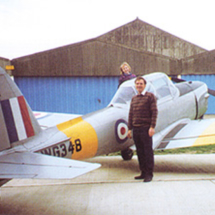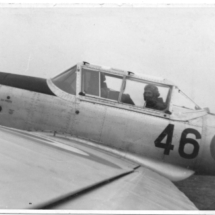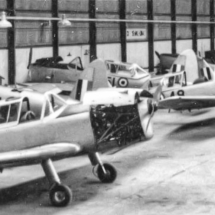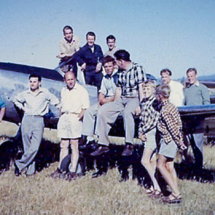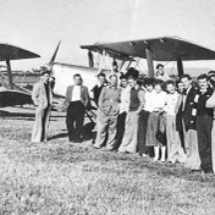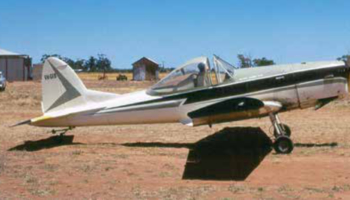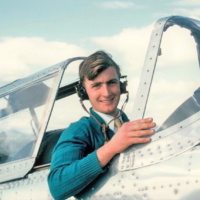
This happy Australian pilot is Lindsay Miller in about 1962, flying what later became Super Chipmunk N7DW! He was a member of the Tasmanian Aero Club and continues today as its historian. Like all planes and people who have been around awhile, a great many changes have marked the lifetimes of both Lindsay and this hard working 1951 deHavilland DHC-1.
Chipmunk N7DW actually began life as a Royal Air Force primary trainer attached to the No. 4 Basic Flying Training School (BFTS) Sywell, Northhampton.
For what it’s worth, it was factory serial number C1-501, RAF registration WG-427. I haven’t dug up any photos of my specific plane from its RAF time, but these photos are likely squadron mate “Chippies” flying out of Sywell in the years following WWII and into the mid 1950s.
In 1956 WG-427 left the RAF for Australia, was certificated as VH-BSQ and served as a civil/military trainer for the Tasmanian Aero Club, Launceton. Upon arrival from Britain,staff and members began the tedious job of stripping the RAF paint and polishing the aluminium on their 4 new planes, Quebec, Romeo, Juliet, and Papa. Club members gathered for the photo below (Lindsay is on the left).
They removed the RAF Coffman cartridge starters leaving The “Armstrong” hand swing as the only start option. Lindsay says they then added the “club colours” to the rudders and had four “beautifully presented, highly polished, modern trainers” to replace the DH-82s Tiger Moths and Austers from the 1930s.
For the first time they had radios instead of lights for communication! Their Chippies had beautifully balanced controls, much better visibility, an extra 15 kts cruising speed could cope with stronger winds and crosswinds. (Even with its clipped wings, Chippy N7DW today remains a pussycat to land in gusty winds, with its long tail and wide gear stance).

“Quebec”, as the club members dubbed VH-BSQ, flew in Tasmania until 1965, when it was sold and converted as the third SA-29 “Spraymaster” at Bankstown, Australia, and recertified as VH-GEB.
Chippy was a crop sprayer!! While it took on this arduous role with the same 145 HP Gypsy Major engine, it received many mods. The front cockpit seat and controls were removed to make way for a chemical hopper, the solo pilot was moved to the rear with a jacked up seat and raised flight controls, and a tall bubble canopy was installed. It also received a modern Scott tailwheel and spray/hopper controls (skin holes and some attachment fittings remained when the rebuild began in 2009!). It flew out of Tintinara, Southern Australia, and had at least one bad landing in a field resulting in major damage.
The trail the airplane had followed was torturous and covered half the globe.
- 1951-55: Produced in England for the RAF, SN BF-370
- 1956: Exported to Australia. 1956-65: Flown by Tasmanian Aero Club
- 1965: Converted to a sprayer: “SA-29 Spraymaster.” Rear cockpit with a tall bubble canopy installed and a hopper in the front. Still had stock engine. 1966: Sold, worked as a glider tug
- April 1971: New Aussie owner began to convert it to Scholl-type Super Chipmunk. Work stalled, and it was sold again
- May 1972: Imported to the United States, sold to Odessa, Texas, owner
- June 1974: Wings modified. Clipped 19 inches; ailerons extended. Installed O-435, engine number two
- June 1978: Sold to another Texas aerobat. Engine changed to GO-540,engine number three, geared
- March 1979 to February 1980: Owner couldn’t afford to replace a trashed engine so sold it back to a previous owner, who put an O-540 in it, engine number four
- September 1987: Sold to Aeronautique Enterprises in Texas. Hopper removed; modified to two place open cockpit
- 1988: Rudder enlarged; beefed up the spar (steel carry-through in-stead of stock bushings)
- From 1974 to 1988: Removed many Spraymaster mods that still remained. Tail modified again. Its shape was changed in 1965, 1974, 1988, and 2012
- November 2000: Sold to Atlanta pilot. Flown very little
- September 2003: Sold to Bruce Moore of H-D Flying Service (and EAA photo ship pilot). Bruce put an overhauled IO-540 on it, engine number five
- Summer 2009: Sold to current owner, Mark Meredith, who restored it over 5 years and 5,000 hours, completing it in 2014
- 2014: International Aerobatic Club competitions
- 2018: Chippy returned to the airshow circuit with Mark, for the first time since 2000!

